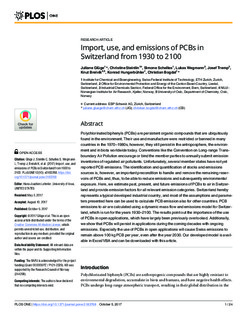| dc.contributor.author | Glüge, Juliane | |
| dc.contributor.author | Steinlin, Christine | |
| dc.contributor.author | Schalles, Simone | |
| dc.contributor.author | Wegmann, Lukas | |
| dc.contributor.author | Josef, Tremp | |
| dc.contributor.author | Breivik, Knut | |
| dc.contributor.author | Hungerbühler, Konrad | |
| dc.contributor.author | Bogdal, Christian | |
| dc.date.accessioned | 2017-10-19T09:02:14Z | |
| dc.date.available | 2017-10-19T09:02:14Z | |
| dc.date.created | 2017-10-09T11:08:51Z | |
| dc.date.issued | 2017 | |
| dc.identifier.citation | Glüge, J., Steinlin, C., Schalles, S., Wegmann, L., Tremp, J., Breivik, K., Hungerbühler, K., & Bogdal, C. (2017). Import, use, and emissions of PCBs in Switzerland from 1930 to 2100. PLoS ONE, 12, e0183768, doi:10.1371/journal.pone.0183768 | nb_NO |
| dc.identifier.issn | 1932-6203 | |
| dc.identifier.uri | http://hdl.handle.net/11250/2460979 | |
| dc.description.abstract | Polychlorinated biphenyls (PCBs) are persistent organic compounds that are ubiquitously found in the environment. Their use and manufacture were restricted or banned in many countries in the 1970±1980s, however, they still persist in the antroposphere, the environment and in biota worldwide today. Conventions like the Convention on Long-range Transboundary Air Pollution encourage or bind the member parties to annually submit emission inventories of regulated air pollutants. Unfortunately, several member states have not yet reported PCB emissions. The identification and quantification of stocks and emissions sources is, however, an important precondition to handle and remove the remaining reservoirs of PCBs and, thus, to be able to reduce emissions and subsequently environmental exposure. Here, we estimate past, present, and future emissions of PCBs to air in Switzerland and provide emission factors for all relevant emission categories. Switzerland hereby represents a typical developed industrial country, and most of the assumptions and parameters presented here can be used to calculate PCB emission also for other countries. PCB emissions to air are calculated using a dynamic mass flow and emissions model for Switzerland, which is run for the years 1930±2100. The results point out the importance of the use of PCBs in open applications, which have largely been previously overlooked. Additionally, we show that PCBs will persist in applications during the coming decades with ongoing emissions. Especially the use of PCBs in open applications will cause Swiss emissions to remain above 100 kg PCB per year, even after the year 2030. Our developed model is available in Excel/VBA and can be downloaded with this article. | nb_NO |
| dc.language.iso | eng | nb_NO |
| dc.relation.uri | https://doi. org/10.1371/journal.pone.0183768 | |
| dc.rights | Navngivelse 4.0 Internasjonal | * |
| dc.rights.uri | http://creativecommons.org/licenses/by/4.0/deed.no | * |
| dc.title | Import, use, and emissions of PCBs in Switzerland from 1930 to 2100 | nb_NO |
| dc.type | Journal article | nb_NO |
| dc.type | Peer reviewed | nb_NO |
| dc.description.version | publishedVersion | nb_NO |
| dc.rights.holder | © 2017 Glüge et al. | nb_NO |
| dc.source.pagenumber | 24 | nb_NO |
| dc.source.volume | 12 | nb_NO |
| dc.source.journal | PLoS ONE | nb_NO |
| dc.source.issue | 10 | nb_NO |
| dc.identifier.doi | 10.1371/journal.pone.0183768 | |
| dc.identifier.cristin | 1503281 | |
| dc.relation.project | Norges forskningsråd: 244298 | nb_NO |
| cristin.unitcode | 7460,57,0,0 | |
| cristin.unitname | Atmosfære og klima | |
| cristin.ispublished | true | |
| cristin.fulltext | original | |
| cristin.qualitycode | 1 | |

